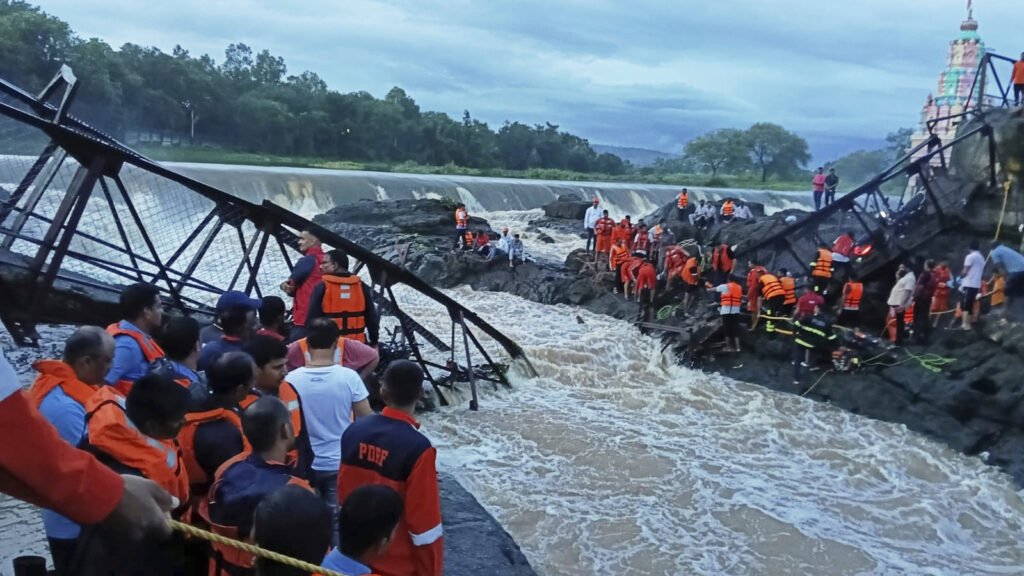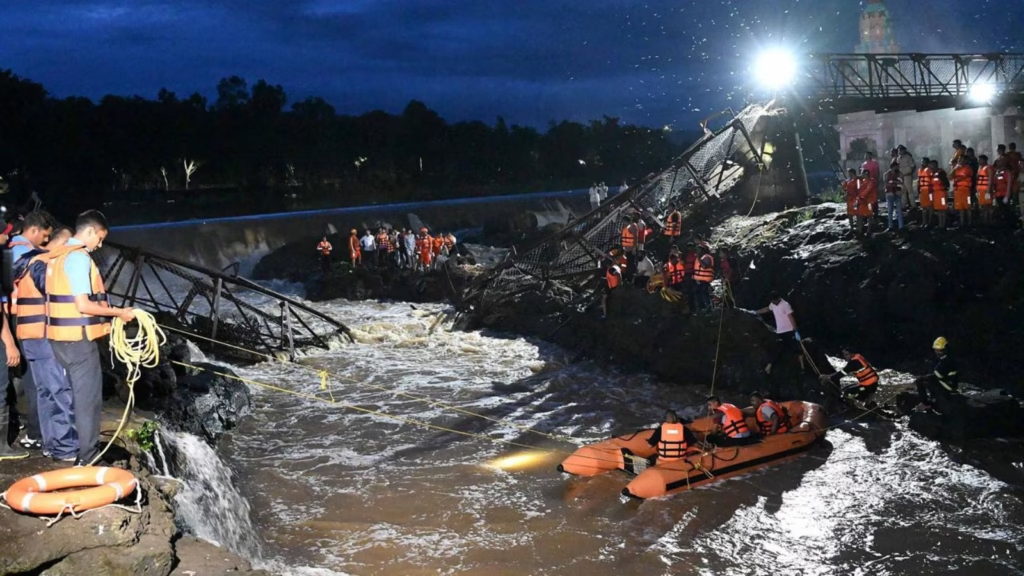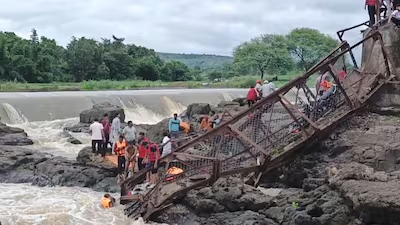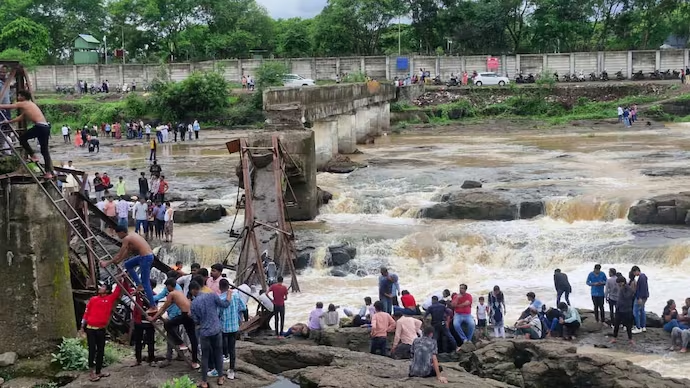On Sunday afternoon, a narrow footbridge spanning the Indrayani River near Talegaon in Pune district collapsed, sending over 100 people plunging into the swollen waters. The collapse claimed four lives and injured 51 others, with rescue teams retrieving 55 survivors over a 15-hour operation.
Pune Bridge Collapse: Ageing and Overloaded
Built nearly 30 years ago—a mix of stone, iron, and cement—the bridge measured 470 ft in length but only 4 ft in width, capable of supporting just a couple of pedestrians or a lone two-wheeler at once. Yet on that afternoon:
- Tourists flocking to Kundmala ignored closure warnings.
- Over 100 to 200+ people, including about 7–8 bikes, were on the bridge.
- The structure was rusted and deteriorated, with potholes crudely patched by locals.
Eyewitnesses described the bridge shaking ominously for nearly five minutes before a section suddenly gave way, hurling people into the raging river below.
Human Toll and Heroic Rescue
Authorities confirmed four fatalities—three identified (Chandrakant Salve, Rohit Mane, Vihaan Mane) and one yet unidentified—and 51 injuries, eight of whom are in critical condition.
The National Disaster Response Force (NDRF), police, fire brigade, and local volunteers worked tirelessly to rescue 55 people including those trapped under debris. Eyewitness Chandrakant Vidhate, crushed beneath girders, helped three people escape before being freed himself—surviving despite serious injuries.

The Pune bridge collapse has exposed severe cracks in the safety standards of public infrastructure. Despite multiple warnings, no immediate action was taken to repair or restrict access to the dilapidated structure. The rusted iron beams, corroded support pillars, and patchwork repairs highlighted a systemic failure that led directly to the Pune bridge collapse. For years, locals raised concerns over the visible deterioration, but administrative apathy allowed the structure to stay functional, making the Pune bridge collapse an avoidable tragedy.
Tourism in the Kundmala region surged during the monsoon, especially around weekends, turning the area into a hotspot for nature lovers and selfie-seekers. Unfortunately, the surge in visitors directly contributed to the overcrowding that precipitated the Pune bridge collapse. With over 200 people and multiple two-wheelers packed onto a narrow 4-ft wide footbridge, the structure stood no chance under the excessive load. The absence of effective crowd control, despite the predictable seasonal rush, further amplified the risk that ultimately resulted in the Pune bridge collapse.
Shared Responsibility: Neglect and Overcrowding
Multiple factors fed into this tragedy:
- Structural Neglect
The bridge had not undergone a recent structural audit, even after locals lodged complaints two years ago urging repairs and closure. It had previously been declared unfit, yet remained open to pedestrians and two-wheelers. - Rust and Potholes
Iron sections were heavily rusted, and potholes were patched with cement blocks—a temporary, unsafe measure. - Overcrowding by Tourists
Kundmala had become a monsoon hotspot, drawing roughly 8,000 visitors each weekend. Visitors ignore warning signs, attracted by the scenic view and selfie opportunities . - Weak Enforcement and Inaction
Closure signs went unheeded, and a lone security staff was deployed only on weekends—insufficient for enforcement.
In the aftermath of the Pune bridge collapse, government officials are now under immense pressure to conduct thorough audits of all aging bridges across Maharashtra. The Deputy CMs announced comprehensive structural assessments to prevent any future Pune bridge collapse type disasters. However, public trust has been shaken. Citizens are demanding not just audits but transparent reporting, timely repairs, and strict accountability to ensure that another Pune bridge collapse does not repeat itself. The ongoing investigation committee is tasked with finding the lapses and recommending stringent safety protocols to avert future Pune bridge collapse incidents.

Swift Response and Accountability
The state government and civil administration responded promptly:
- CM Fadnavis declared ₹5 lakh ex-gratia for each deceased family and pledged full medical coverage for the injured.
- Deputy CMs Ajit Pawar and Eknath Shinde announced structural audits across river bridges and investigations into lapses.
- A five-member committee has been formed to probe administrative failures and recommend reforms.
- A new bridge worth ₹7–8 crore had been sanctioned earlier, but monsoon delays stalled construction.
The victims of the Pune bridge collapse and their families have received financial assistance, but monetary compensation cannot fill the void left by lost lives. Survivors are calling for justice, emphasizing that better maintenance and prompt administrative action could have easily prevented the Pune bridge collapse. Public outrage is building across social media and civic forums as citizens question why safety warnings were ignored and why previous complaints about the bridge’s condition were dismissed, inevitably leading to the Pune bridge collapse.
Lessons & Safeguards for the Future
The Talegaon tragedy is a wake-up call pointing to urgent infrastructure reforms:
| Area | Issue | Recommendation |
|---|---|---|
| Structural Audits | Outdated/neglected bridges | Mandatory regular inspections and repairs |
| Crowd Control | Tourist hotspots lack capacity management | Install barriers, deploy enforcement staff |
| Public Awareness | Ignored warnings contribute to risk | Launch safety campaigns, visible signage |
| Monsoon Preparedness | Seasonal surges not planned for | Temporary closures during risky periods |
| Administrative Action | Delays in sanctioned construction | Implement fast-track project timelines |
Experts also stress the importance of learning from past disasters (e.g., Mumbai, Morbi bridge collapses) by updating safety protocols and strengthening accountability frameworks.
The Talegaon bridge collapse highlights a deadly intersection of outdated infrastructure, unchecked tourism, and administrative apathy. While rescue efforts saved dozens, and compensations were promptly announced, the core issues of maintenance, crowd regulation, and monsoon preparedness remain unresolved.

The path forward demands proactive measures: enforcing closures of unsafe structures, investing in audits and repairs, controlling tourist crowds, and ensuring swift execution of safety-critical projects.
As Maharashtra moves forward, the Pune bridge collapse serves as a crucial case study for disaster preparedness. From rust inspections to crowd management, each factor contributing to the Pune bridge collapse must be meticulously examined. Activists and safety experts suggest that bridges like the one involved in the Pune bridge collapse should be mandatorily closed when flagged unsafe, irrespective of tourist or local convenience. Learning from the Pune bridge collapse is essential if state authorities wish to prevent another such heartbreaking event.
This tragic event underlines the urgent need to prioritise public safety over convenience and photo ops, to prevent further loss of life during the next monsoon season—and beyond.












